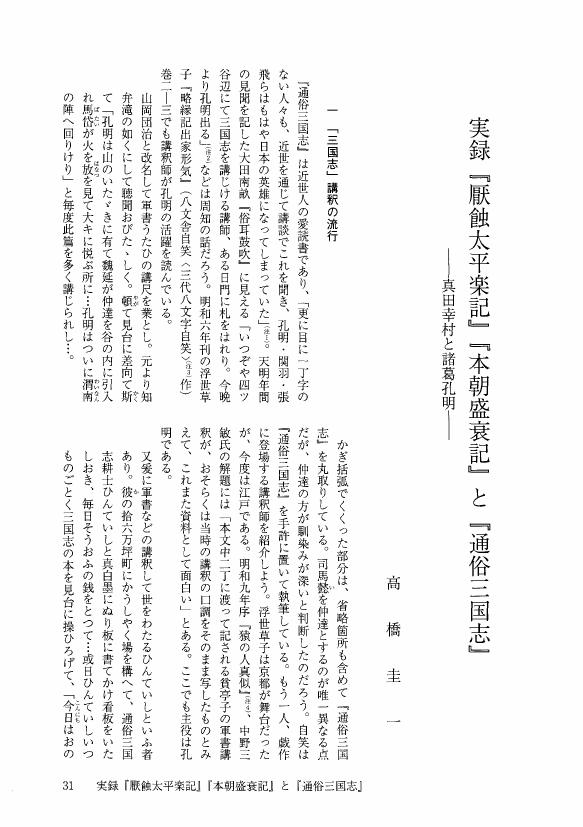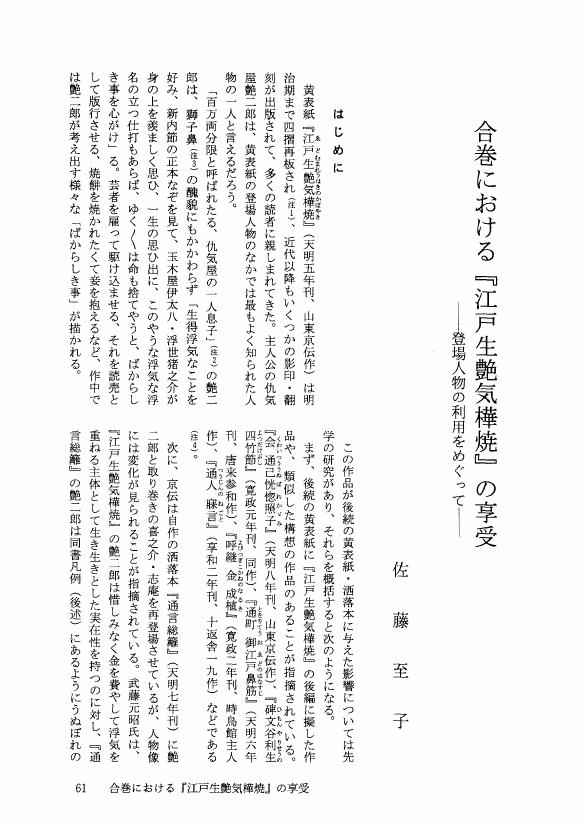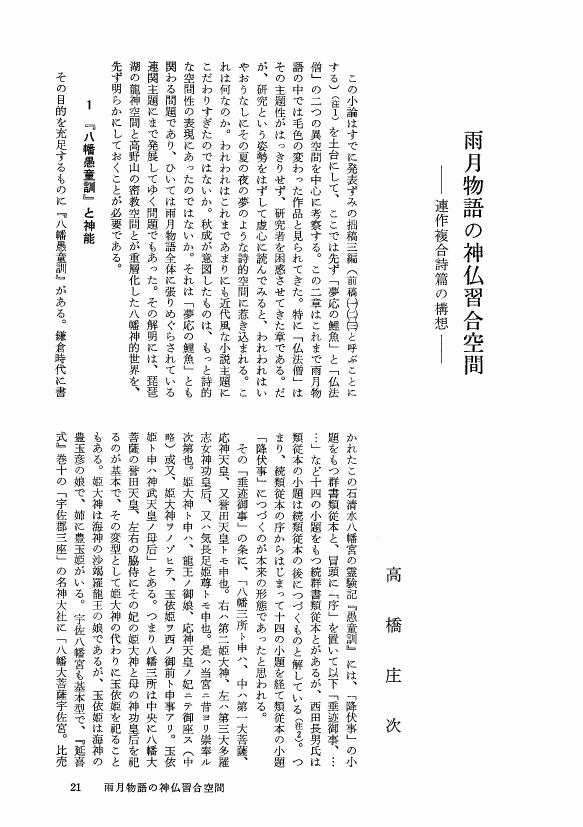1 0 0 0 OA 大塩平八郎物実録の展開とその受容
- 著者
- 荻原 大地
- 出版者
- 日本近世文学会
- 雑誌
- 近世文藝 (ISSN:03873412)
- 巻号頁・発行日
- vol.112, pp.69-80, 2020 (Released:2021-01-31)
This article chronologically traces the development of the true stories of Ōshio-Heihachirō from the Edo Period to the Meiji Period to see their whole aspect in a new perspective. The stories can be classified into the following five groups; the “Naniwa-hikki” series (Naniwa-hikki, Kyōran-taihei-ki, Naniwazu-ashi-no-hanashi, and Miyo-taihei-ki), Taihei-kagami, Tenpō-naniwa-hanashi, Tenpō-taihei-ki, Shinpen-tenpō-taihei-ki. In Tenpō-naniwa-hanashi, Tenpō-taihei-ki, and Shinpen-tenpō-taihei-ki there appeared an additional episode of Heihachirō’s younger days. The narrative theme came to be more centered on the character than the rebellion. In this way Tenpō-naniwa-hanashi and Tenpō-taihei-ki became a narrative model for the modern version of Ōshio-Heihachirō stories such as Naniwa-no-ume-ōshio-banashi and Tenma-suiko-den.
1 0 0 0 OA 実録『厭蝕太平楽記』『本朝盛衰記』と『通俗三国志』 ―真田幸村と諸葛孔明―
- 著者
- 高橋 圭一
- 出版者
- 日本近世文学会
- 雑誌
- 近世文藝 (ISSN:03873412)
- 巻号頁・発行日
- vol.89, pp.31-42, 2009 (Released:2017-04-28)
1 0 0 0 OA 蔦屋重三郎出板書目年表稿(下)
- 著者
- 鈴木 俊幸
- 出版者
- 日本近世文学会
- 雑誌
- 近世文藝 (ISSN:03873412)
- 巻号頁・発行日
- vol.36, pp.53-73, 1982 (Released:2017-04-28)
1 0 0 0 OA 口合本と地口本 ―その変遷
- 著者
- 中島 穂高
- 出版者
- 日本近世文学会
- 雑誌
- 近世文藝 (ISSN:03873412)
- 巻号頁・発行日
- vol.72, pp.58-74, 2000 (Released:2017-04-28)
1 0 0 0 OA 合巻における『江戸生艶気樺焼』の享受 ―登場人物の利用をめぐって―
- 著者
- 佐藤 至子
- 出版者
- 日本近世文学会
- 雑誌
- 近世文藝 (ISSN:03873412)
- 巻号頁・発行日
- vol.85, pp.61-73, 2007 (Released:2017-04-28)
1 0 0 0 OA 雨月物語の神仏習合空間 ―連作複合詩篇の構想―
- 著者
- 高橋 庄次
- 出版者
- 日本近世文学会
- 雑誌
- 近世文藝 (ISSN:03873412)
- 巻号頁・発行日
- vol.50, pp.21-33, 1989 (Released:2017-04-28)
1 0 0 0 OA 姫路騒動実録の生成と展開
- 著者
- 田中 則雄
- 出版者
- 日本近世文学会
- 雑誌
- 近世文藝 (ISSN:03873412)
- 巻号頁・発行日
- vol.113, pp.33-47, 2021 (Released:2021-07-31)
In July 10, 1751 or the fourth year of the Kan’en Period Kawai-Kageyuzaemon, the chief retainer of the Sakai family in the Himeji Domain, committed suicide after killing Inuzuka-Yūnai and Honda-Minbuzaemon at his home. This incident was recorded in Kiyō-ingo. There were originally three variants of the regional document which were further supplemented and revised into other editions. Chūshin-Kawai-jikki is another record of the incident made independently of Kiyō-ingo. This document must have been written by a local writer because of its rich references to the domain’s places, persons, and traditions. It represented Kawai as a person who cared for the local people so much that he came into collision with Inuzuka and Honda and couldn’t help solving it in such a tragic way. Both Kiyō-ingo and Chūshin-Kawai-jikki provide a glimpse into the way regional events were recorded and revised in early modern times.
1 0 0 0 OA 御伽草子「はちかづき」の草双紙への展開 ―西村屋與八板を中心に―
- 著者
- 松原 秀江
- 出版者
- 日本近世文学会
- 雑誌
- 近世文藝 (ISSN:03873412)
- 巻号頁・発行日
- vol.37, pp.1-15, 1982 (Released:2017-04-28)
1 0 0 0 OA 浅井了意関係新資料 『やうきひ物語(長恨歌抄)』について
- 著者
- 坂巻 甲太
- 出版者
- 日本近世文学会
- 雑誌
- 近世文藝 (ISSN:03873412)
- 巻号頁・発行日
- vol.25.26, pp.26-34, 1976 (Released:2017-04-28)
1 0 0 0 近世後期類題和歌集編纂の一齣
- 著者
- 亀井 森
- 出版者
- 日本近世文学会
- 雑誌
- 近世文藝 (ISSN:03873412)
- 巻号頁・発行日
- vol.90, pp.30-43, 2009
1 0 0 0 OA 林羅山の国文学研究
- 著者
- 小高 敏郎
- 出版者
- 日本近世文学会
- 雑誌
- 近世文藝 (ISSN:03873412)
- 巻号頁・発行日
- vol.6, pp.1-10, 1961 (Released:2017-04-28)
1 0 0 0 OA 大淀三千風略伝
- 著者
- 岡本 勝
- 出版者
- 日本近世文学会
- 雑誌
- 近世文藝 (ISSN:03873412)
- 巻号頁・発行日
- vol.14, pp.15-25, 1968 (Released:2017-04-28)
1 0 0 0 OA 『椿説弓張月』の構想と謡曲「海人」
- 著者
- 大高 洋司
- 出版者
- 日本近世文学会
- 雑誌
- 近世文藝 (ISSN:03873412)
- 巻号頁・発行日
- vol.79, pp.17-28, 2004 (Released:2017-04-28)
1 0 0 0 OA 宮島大芝居劇場考
- 著者
- 角田 一郎
- 出版者
- 日本近世文学会
- 雑誌
- 近世文藝 (ISSN:03873412)
- 巻号頁・発行日
- vol.18, pp.47-60, 1970 (Released:2017-04-28)
1 0 0 0 一枝軒野村尚房の伝と文事
- 著者
- 神作 研一
- 出版者
- 日本近世文学会
- 雑誌
- 近世文藝 (ISSN:03873412)
- 巻号頁・発行日
- vol.63, pp.24-38, 1996
1 0 0 0 滝川昌楽素描:―近世前期京都の一儒者像―
- 著者
- 勝又 基
- 出版者
- 日本近世文学会
- 雑誌
- 近世文藝 (ISSN:03873412)
- 巻号頁・発行日
- vol.75, pp.17-30, 2002
1 0 0 0 OA 追悼暉峻康隆先生
- 著者
- 青山 忠一
- 出版者
- 日本近世文学会
- 雑誌
- 近世文藝 (ISSN:03873412)
- 巻号頁・発行日
- vol.75, pp.132, 2002 (Released:2017-04-28)
1 0 0 0 ひいき連中について:―道頓堀一七八九~一八二九―
- 著者
- 松平 進
- 出版者
- 日本近世文学会
- 雑誌
- 近世文藝 (ISSN:03873412)
- 巻号頁・発行日
- vol.30, pp.70-80, 1979
1 0 0 0 OA 『好色一代男』と『京童』
- 著者
- 藤原 英城
- 出版者
- 日本近世文学会
- 雑誌
- 近世文藝 (ISSN:03873412)
- 巻号頁・発行日
- vol.94, pp.1-16, 2011 (Released:2017-04-28)
1 0 0 0 OA 元禄の添削
- 著者
- 神作 研一
- 出版者
- 日本近世文学会
- 雑誌
- 近世文藝 (ISSN:03873412)
- 巻号頁・発行日
- vol.81, pp.17-32, 2005 (Released:2017-04-28)













